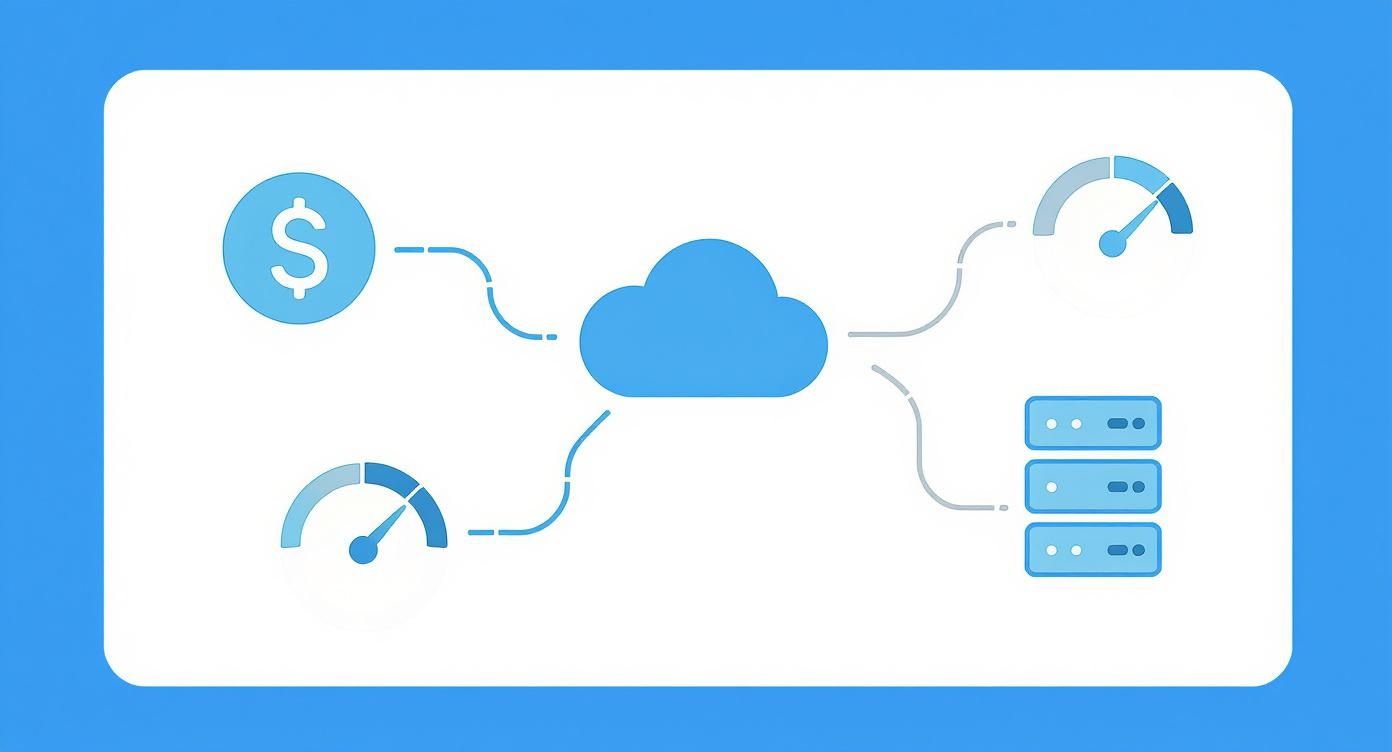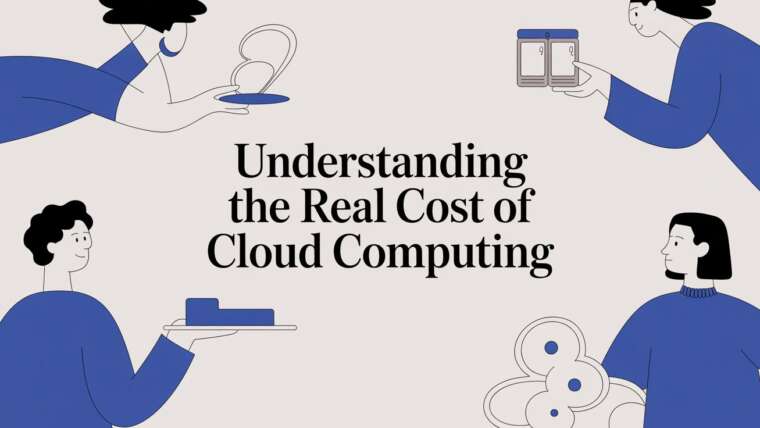Cloud management services are essentially third-party experts who take the wheel of your entire cloud infrastructure. They handle everything from servers and storage to networks and the applications that run on them.
Think of them as a specialized pit crew for your high-performance cloud environment. They're the ones doing the performance tuning, security monitoring, and cost optimization, which frees up your team to focus on winning the race: hitting your core business goals.
What Are Cloud Management Services, Really?
Let’s stick with that race car analogy for a moment. Imagine your cloud environment is a powerful, finely-tuned machine with massive potential. But to actually win, you need a skilled pit crew monitoring fuel levels, checking the engine, and strategizing every single lap. Without that expert team, the car could easily run out of gas, suffer a mechanical failure, or just not perform at its best.
That’s exactly what cloud management services do for your business. They’re your dedicated pit crew.
But they aren't just sitting around waiting to fix problems. These services provide a proactive, all-encompassing framework for overseeing, optimizing, and securing your entire cloud presence. This is a huge deal, as it offloads the immense complexity of managing dynamic cloud resources, a task that can quickly overwhelm even the most skilled in-house IT teams. The constant grind of monitoring, patching, and keeping costs in check is a full-time job in itself.
Core Pillars of Cloud Management Services
At its heart, cloud management is all about bringing order and efficiency to the potentially chaotic world of cloud computing. As businesses adopt more cloud tech, they often end up with sprawling, complex setups spread across multiple providers like AWS, Azure, or Google Cloud. A dedicated service provider steps in to tame that complexity.
The table below breaks down their main responsibilities, which are absolutely critical for success.
| Management Pillar | Core Function | Business Impact |
|---|---|---|
| Cost Management | Continuously monitors spending, identifies idle or underutilized resources, and applies optimization strategies like right-sizing and reservations. | Prevents budget overruns, improves ROI on cloud spend, and frees up capital for other business initiatives. |
| Performance Monitoring | Tracks application and infrastructure health 24/7, using advanced tools to detect bottlenecks, predict issues, and ensure optimal performance. | Guarantees a smooth user experience, minimizes downtime, and ensures services meet performance expectations. |
| Security & Compliance | Implements and manages robust security controls, from threat detection to identity access management, while ensuring the environment meets industry regulations. | Protects sensitive data from cyber threats, avoids costly compliance fines, and builds trust with customers. |
| Operations & Automation | Automates routine tasks like patching, backups, and resource provisioning to reduce manual effort and human error. | Increases operational efficiency, accelerates deployment cycles, and allows the internal team to focus on innovation. |
Ultimately, a provider’s role is to transform the cloud from a powerful but complicated tool into a genuine strategic asset. By handling the nitty-gritty technical details, they let your business focus on crossing the finish line, not getting lost in the engine room.
A Rapidly Growing Necessity
It’s no surprise that the demand for these expert services is surging. More and more organizations are realizing just how challenging it is to go it alone. The global cloud managed services market tells the story perfectly.
Recent data shows the market size was around USD 137.33 billion and is on track to hit USD 482.93 billion in the next decade. That's a compound annual growth rate of 13.4%. This explosive growth points to a crucial business reality: managing a modern cloud environment isn’t just an IT task anymore; it's a specialized discipline.
Our comprehensive guide to cloud computing management services dives deeper into how these partnerships function. By handing over the keys to a dedicated provider, companies gain immediate access to expert knowledge, advanced tools, and round-the-clock support, turning their cloud investment into a reliable and powerful engine for growth.
The Five Critical Components of Managed Cloud Services
To really get what cloud management services bring to the table, it helps to break them down into their core jobs. Think of it like popping the hood on a high-performance race car. What you see is a collection of specialized parts working in perfect sync. A proper managed service isn't one single thing; it's a suite of five interconnected components that keep your cloud running securely, efficiently, and in lockstep with your business goals.
Each piece handles a specific, vital area of your cloud operations. When they all work together, they transform a potentially messy cloud setup into a well-oiled machine. This is where a provider's real expertise comes into play, moving way beyond simple upkeep to active, strategic management of your digital infrastructure.
This infographic breaks down the main pillars of cloud management, showing how cost, performance, and server oversight are all tied together.

It’s a great visual for how these different areas are all handled under one unified strategy, making sure nothing falls through the cracks.
1. Security and Compliance Management
In any cloud environment, security is everything. A managed service provider is your first line of defense, putting in place and managing a tough security posture. This isn't just about basic firewalls. We're talking continuous threat monitoring, tight control over who can access what, and data encryption to shield your sensitive information from increasingly clever cyberattacks.
Just as critical is compliance. If you're in an industry like healthcare or finance, you're bound by strict data rules like HIPAA or PCI-DSS. A huge part of cloud management services is ensuring your infrastructure meets those standards, helping you sidestep massive fines and damage to your reputation.
2. Performance Monitoring and Optimization
Your apps are only as good as they perform. Slow load times or surprise downtime can hit your revenue and erode customer trust in an instant. This component means keeping a 24/7 watch on your entire cloud infrastructure, tracking everything from server CPU usage to how fast your applications are responding.
Using advanced tools, providers can spot bottlenecks and predict problems before they ever cause an outage. For instance, they can see a database is about to hit its limit and proactively scale it up, making sure a financial services app stays online during peak trading hours. This constant watch keeps everything humming along at peak efficiency.
A proactive approach to performance is a must. According to Verizon, a staggering 60% of businesses that experience a major data loss shut their doors within six months. This really drives home the importance of the uptime and reliability that managed services deliver.
3. Cost Management and Governance
Without a watchful eye, cloud spending can spiral out of control. Fast. This is honestly one of the most valuable things a managed service can do. Experts use specialized tools to track your cloud usage in real-time, sniffing out wasted spend on idle machines or over-provisioned resources you’re paying for but not using.
This usually involves a few key moves:
- Resource Right-Sizing: Adjusting server sizes to perfectly match what your workload actually needs. No more paying for horsepower you don't use.
- Identifying Idle Assets: Finding and shutting down resources that aren't being used, like development servers accidentally left running over the weekend.
- Applying Reserved Instances: Committing to long-term use with a cloud vendor like AWS or Azure to lock in huge discounts for predictable workloads.
This disciplined approach to financial operations, often called FinOps, helps businesses rack up serious cost savings and get a much better return on their cloud investment.
4. Automation and Orchestration
Doing things by hand isn't just slow; it's a recipe for human error. A cornerstone of modern cloud management is automation. This means scripting and orchestrating all the routine stuff like software patching, spinning up new servers, and pushing configuration updates.
For example, instead of a team member manually deploying a new server, an automated workflow can get it done in minutes with perfect consistency every time. Automation also powers auto-scaling, which automatically adds resources to handle a traffic spike, like on a retail site during a Black Friday sale, and then scales them back down to save money. It just makes your operations faster, more reliable, and way more efficient.
5. Backup and Disaster Recovery
Finally, every business needs a safety net. The backup and disaster recovery component ensures you can keep the lights on even if the worst happens. This service involves creating regular, automated backups of your most important data and applications.
Even more importantly, it means having a clear disaster recovery (DR) plan. If your primary data center goes down because of an outage or a natural disaster, a managed service can quickly flip the switch to a secondary site, getting you back online with minimal disruption. In a world that runs on digital availability, that kind of resilience is absolutely fundamental.
Unlocking Real Business Benefits with Cloud Management
Bringing in a cloud management service isn't just a technical tweak. It's a core business decision that pays off in real, tangible ways. When you hand over the complex job of cloud oversight to a team of dedicated pros, you unlock a whole host of advantages that directly boost your bottom line, agility, and overall resilience.
This is about much more than just outsourcing a few IT tasks. It's about gaining a genuine competitive edge by turning your cloud infrastructure from a nagging cost center into a powerful engine for growth. The positive effects ripple across the entire company, from the finance department right through to daily operations.
Driving Significant Cost Savings
One of the first and most powerful benefits you'll see is a serious drop in your cloud spending. Without an expert keeping watch, cloud bills have a nasty habit of becoming unpredictable and bloated. Managed service providers bring a disciplined, strategic approach to your cloud finances.
They're specialists in hunting down and eliminating waste. Think shutting down servers that are sitting idle or resizing resources that are way overprovisioned for what they actually do. This hands-on approach makes sure you only pay for what you actually use. For a deeper dive, check out our guide on cloud cost optimisation for more practical strategies to trim your budget.
This relentless focus on optimization leads to big savings. In fact, recent analysis shows that businesses can slash their cloud spending by 30% or more with the right management, freeing up that cash for more important initiatives.
Think of it this way: Leaving your cloud unmanaged is like leaving the lights on in an empty office building all night. A managed service provider is the facilities manager who diligently turns off every unnecessary light, saving you money every single day.
Gaining Access to Specialized Expertise
Let's be honest: hiring, training, and keeping a full-time team of cloud experts is incredibly expensive and a constant headache. The tech landscape changes daily, with new tools and security threats popping up all the time. Cloud management services give you instant access to a deep bench of specialists without the massive overhead of building that team yourself.
These folks live and breathe cloud technology. Their expertise covers all the major platforms, from AWS and Azure to Google Cloud, ensuring your setup is built on solid, industry-leading practices. This frees up your internal team to focus on what they do best: driving your core business forward, not trying to become cloud infrastructure gurus on the fly.
A quick look at this table shows just how different the two approaches are.
Comparing In-House vs. Managed Cloud Services
Here’s a side-by-side comparison that highlights the strategic advantages of working with a managed service provider versus trying to handle everything with an in-house team.
| Aspect | In-House Management | Managed Cloud Services |
|---|---|---|
| Skillset | General IT knowledge, often stretched thin across many responsibilities. | Deep specialization in cloud architecture, security, and cost optimization. |
| Availability | Typically limited to standard business hours, with on-call rotations for emergencies. | 24/7/365 monitoring and support from a dedicated team of engineers. |
| Tools & Tech | Limited by budget and the team's ability to learn and implement new tools. | Access to advanced, enterprise-grade tools for monitoring, security, and automation. |
| Focus | Reactive firefighting and maintaining existing systems. | Proactive optimization, strategic planning, and continuous improvement. |
As you can see, the value isn't just in the technical skills, but in the proactive, strategic focus that a dedicated partner brings to the table.
Enhancing Security and Compliance
In a world where cyberattacks are getting smarter and more frequent, rock-solid security isn't just a nice-to-have; it's non-negotiable. Managed service providers put security at the very top of their list, implementing a multi-layered defense to protect your sensitive data around the clock.
This isn't a one-and-done setup. It involves:
- Continuous Threat Monitoring: Actively hunting for and neutralizing potential threats before they can do any real damage.
- Identity and Access Management: Making sure only the right people can access your critical systems and data.
- Compliance Adherence: Configuring your environment to meet tough industry regulations like HIPAA, PCI DSS, or GDPR, which helps you sidestep massive fines.
Boosting Scalability and Agility
Finally, professional cloud management ensures your infrastructure can grow right alongside your business without any friction. As your needs change, a managed service provider can instantly scale resources up or down. This means you have all the power you need during a big product launch but aren't burning cash during slower periods.
This kind of agility lets you jump on market opportunities much faster, without being held back by technology. You can roll out new features or expand into new territories with total confidence, knowing your cloud foundation is solid and ready for whatever you throw at it.
How AI and Automation Are Shaping Cloud Management
The future of cloud management is getting smarter. Artificial Intelligence (AI) and Machine Learning (ML) aren't just buzzwords anymore; they're actively changing how businesses run their cloud environments. These technologies are making things more efficient, more resilient, and way more secure.
Think of them as a massive upgrade for your cloud management services, allowing you to shift from just reacting to problems to actively predicting and preventing them.

Imagine your cloud engineers are like skilled air traffic controllers, watching screens and reacting to alerts. Now, give that team a supercomputer that can see patterns invisible to the human eye, analyze millions of data points instantly, and take corrective action all on its own. That's what AI and automation bring to the table.
The Rise of Predictive Analytics
One of the most powerful ways AI is changing the game is through predictive analytics. Instead of waiting for a server to crash or a security breach to hit, AI-powered tools can see trouble coming. By crunching historical performance data and network traffic, these systems spot the tiny, subtle red flags that pop up before a major incident.
For example, an AI might notice a tiny, consistent increase in memory usage on a key server that signals an impending failure. It can then automatically alert your team or even shift workloads to another server to prevent any downtime. This is a huge leap forward from the old "break-fix" model of IT support.
Real-Time Resource Optimization
Cost and resource management is another area where AI is making a massive difference. ML algorithms are incredibly good at figuring out exactly how much computing power you need at any given moment. They constantly analyze workloads and adjust servers, storage, and network bandwidth in real time.
This means you stop paying for resources you aren't using. This dynamic approach ensures your infrastructure is perfectly matched to demand, avoiding both overprovisioning (which wastes money) and underprovisioning (which kills performance).
AIOps (AI for IT Operations) is the industry term for this. It's all about using AI to automate and smarten up IT operations. AIOps tools connect the dots between all your monitoring systems, find the root cause of a problem automatically, and can even trigger self-healing scripts to fix issues without anyone lifting a finger. This cuts down on downtime and frees up your best engineers to build new things instead of fighting fires.
Driving Market Growth with Intelligent Services
The move toward AI and ML is a huge driver of industry growth. As businesses generate more and more data, the need for intelligent security and compliance tools becomes critical. In the U.S. alone, the cloud managed services market is expected to grow at a CAGR of 10.55% over an eight-year period, largely because of this demand for smarter, automated services.
You can explore more data on the U.S. cloud managed services market to see how AI is shaping its future. The trend is clear: companies are actively looking for AI-powered services to get real-time insights into their infrastructure's health and security.
Key Applications of AI in Cloud Management
- Automated Incident Response: When an issue pops up, AI can instantly classify how serious it is, find the root cause, and kick off automated fixes, slashing the time it takes to resolve problems.
- Enhanced Security Posture: AI algorithms can watch network traffic for sophisticated cyber threats, blocking them in real time with a level of precision that manual monitoring just can't match.
- Proactive Maintenance: ML models can predict when a piece of hardware is about to fail based on its performance data. This allows for maintenance before a critical component dies and causes an outage.
Ultimately, AI and automation are building smarter, more self-sufficient, and fundamentally more reliable cloud environments. They're essential tools for any modern cloud management services strategy.
Implementing Smart Cloud Management Practices
Getting cloud management services to work for you is about more than just signing a contract. It's a strategic move. To see a real return on your investment, you need to lay the right groundwork. That means setting clear goals, picking the right partner, and building a system for constant improvement.
Think of it like building a house. You wouldn't just start laying bricks without a detailed blueprint, right? A solid cloud strategy is that blueprint. It defines what success looks like and maps out the steps to get there, helping you dodge common pitfalls and make sure the whole project is built on a solid foundation.

Start with a Comprehensive Cloud Strategy
First things first: you need to decide what you’re trying to accomplish. Are you chasing lower operational costs? Better security? The ability to scale on a dime? Maybe it's all of the above. These goals will steer every decision you make down the road.
This initial planning phase requires an honest look at your current IT setup. You'll need to understand your existing workloads, map out their dependencies, and figure out which applications are actually a good fit for the cloud. Getting this clarity upfront prevents expensive mistakes and gets your cloud journey started on the right foot.
Select the Right Managed Service Provider
Picking a managed service provider (MSP) is a make-or-break decision. Not all providers are created equal, so you have to vet them based on their real-world expertise, their service level agreements (SLAs), and their track record. A great partner does more than just fix things when they break; they act as a strategic advisor.
Here are a few things to zero in on:
- Technical Expertise: Do they have certified pros for the specific cloud platforms you use, like AWS, Azure, or Google Cloud?
- Service Level Agreements (SLAs): What uptime do they actually guarantee? How fast will they jump on an incident? These commitments need to be spelled out in black and white.
- Security and Compliance: Can they handle the specific regulatory hoops your industry requires, like HIPAA or PCI DSS?
- Client References: Don't just take their word for it. Ask for case studies or to speak with companies like yours.
A strong partnership with an MSP is foundational. Their ability to manage not just infrastructure but also the vast amounts of data running on it is crucial for gaining business insights and maintaining a competitive edge.
The demand for people who know how to handle this data is exploding. The global market for cloud-based data management services hit USD 43.83 billion recently and is on track to reach a staggering USD 173.63 billion within six years. This just goes to show that more and more businesses realize that smart data management is where the real value is. You can get more insights on this booming market and its effect on cloud data management services.
Establish Clear Governance and Foster Optimization
Once you've got a provider on board, the next move is to lay down some clear governance policies. This is the rulebook for how your cloud resources are used, managed, and locked down. It should cover everything from cost controls and access management to compliance protocols, keeping your environment tidy and efficient.
Finally, remember that effective cloud management services aren't a "set it and forget it" deal. The best results come from building a culture of continuous optimization. This means working with your MSP to run regular performance reviews, pore over spending reports, and hunt for new ways to get more efficient. It's an ongoing process that ensures your cloud environment grows and changes right along with your business.
Your Path to Cloud Excellence
This journey through cloud management services is designed to take you from understanding the basic ideas to putting them into practice. If there's one thing to take away, it's this: professional cloud management isn't a luxury anymore. For any business serious about using the cloud, it's a fundamental requirement for stability, security, and growth.
This isn't just about handing off a few IT tasks to someone else; it's about building a strategic partnership. Investing in these services is an investment in your company’s future. The right provider doesn't just put out fires. They proactively stop problems from happening in the first place and find new ways to make you more efficient and innovative.
From Using the Cloud to Mastering It
The best next step is to take a hard, honest look at your current cloud setup. Where are the headaches? Are your costs all over the place? Is your team constantly distracted by routine maintenance instead of building what's next? These are the exact spots where expert management can bring immediate relief.
Think about how a dedicated partner could lift operational burdens, lower security risks, and help you move from simply using the cloud to truly mastering it. That shift is what creates a real competitive advantage. For instance, a provider with deep expertise in a specific platform can completely change the game. You can check out our guide on finding a managed service provider for AWS to see how that kind of specialized knowledge transforms an environment.
The real goal of cloud management services is to turn your cloud infrastructure into a silent, powerful engine that drives your business. It should empower your team, not bog them down with complexity.
Taking Action for a Competitive Edge
A well-run cloud environment is the bedrock of agility and growth. It lets you launch products faster, scale up to meet demand in a heartbeat, and protect your digital assets from an endless stream of threats. Without this expert oversight, you’re just falling behind competitors who have already made this move.
The path forward starts with acknowledging that managing a complex cloud infrastructure is its own specialized skill. By partnering with experts, you get instant access to the tools, processes, and deep knowledge needed to optimize everything for cost, performance, and security. It's a decision that lets you get back to focusing on your core business, confident that your tech backbone is in the hands of pros who are dedicated to your success.
Got Questions About Cloud Management Services?
If you're exploring cloud management services, you've probably got a few questions. That's a good thing. Getting clear, honest answers is the only way to figure out what’s right for your business. Let's tackle some of the most common things people ask.
Cloud Management vs. Cloud Hosting: What's the Difference?
This is a big one, and it’s easy to get them mixed up.
Think of it this way: cloud hosting is like leasing an empty warehouse. The landlord hands you the keys to a big, empty space. The infrastructure is there, but that’s it. You're responsible for everything inside: setting up the shelves, installing security cameras, paying the utilities, and making sure the place doesn't fall into chaos.
Cloud management services, on the other hand, are like hiring a full-service logistics manager for that warehouse. They don't just give you the space; they organize the inventory, manage security, optimize your utility bills to save you money, and handle all the day-to-day maintenance. You just focus on running your business.
Who Is Responsible for Data Security?
When you bring in a managed service provider (MSP), security becomes a team sport, but your provider does most of the heavy lifting. You're still in charge of who gets access to your apps and data, but the MSP takes on the massive job of securing the underlying cloud infrastructure itself.
This isn't just a small task. They handle critical jobs like:
- Setting up and managing firewalls and intrusion detection systems.
- Keeping a vigilant eye on your environment 24/7, hunting for threats.
- Making sure the infrastructure is buttoned up and compliant with regulations like HIPAA or PCI DSS.
Essentially, your MSP acts as your dedicated security squad, building and defending the fortress so you can operate safely inside. It's a partnership that seriously beefs up your defenses against a world of ever-smarter cyber threats.
How Does Pricing Typically Work?
Pricing isn't a one-size-fits-all deal; it usually comes in a few different flavors. A really popular option is the fixed-fee model. You pay a set, predictable amount each month for a specific list of services. It’s fantastic for anyone who needs to stick to a budget.
Another common route is a per-device or per-user model, where the cost grows as your team or infrastructure does. Then there's the consumption-based model, where your bill is a percentage of your monthly cloud spend. This approach is interesting because it aligns your provider's goals with yours. They only make more if you spend more, so they're motivated to help you find savings. Always make sure you know exactly how a provider’s pricing works before you sign on the dotted line.
When Is a Business Ready to Make the Switch?
You'll know it's time when the care and feeding of your cloud environment starts pulling focus from what your business actually does. Is your team spending more time patching servers, wrestling with configurations, and trying to decipher your cloud bill than they are building new products or helping customers? That’s a giant red flag.
If your cloud costs are swinging wildly from month to month, or if the thought of a compliance audit keeps you up at night, it's time to call in the experts. The entire point is to transform your cloud from a time-sucking operational headache into a powerful engine for growth.
Ready to take control of your cloud costs with a simple, powerful tool? CLOUD TOGGLE helps you automatically shut down idle cloud resources, saving you money without compromising access. Start your free 30-day trial and see how much you can save at https://cloudtoggle.com.




